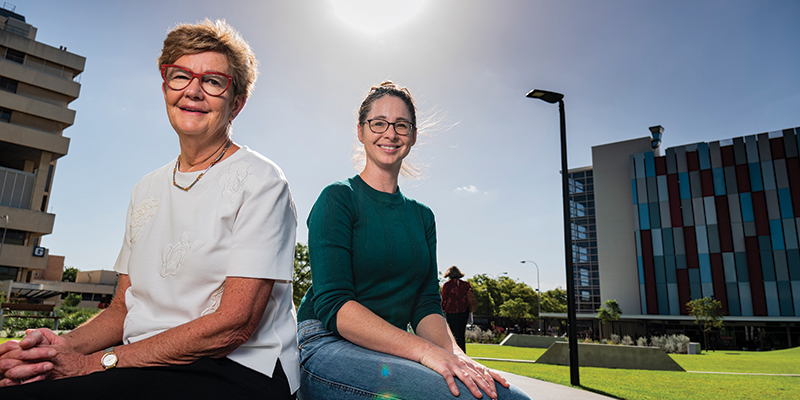
Professor Prue Hart and Dr Shelley Gorman
For decades Australians have been told to minimise sun exposure to prevent skin cancer, however researchers at Telethon Kids Institute have challenged that message, based on multi-pronged research that shows some sun exposure may hold important health benefits.
Head of the Institute’s Inflammation Team, Professor Prue Hart, said the results from three significant research streams at the Institute have made it increasingly apparent that some exposure to direct sunlight is important for good health – and not just because it produces vitamin D.
In what she described as the ‘next big wave of knowledge,’ Professor Hart said research led by herself, Dr Shelley Gorman and Dr Debbie Palmer pointed to multiple beneficial molecules being created on the skin by exposure to direct sunlight.
“Our combined work stretches across autoimmune, metabolic disease and skin allergies, and carries the common thread that there are some beneficial effects of sunlight, not all of it vitamin D-related,” Professor Hart said. “There are other important mediators that need to be considered and researched.
“Based on this, we think Australian authorities may have been too strict with the ‘sun safe’ messages, and as a result people aren’t getting enough exposure because of the fear of skin cancer.”
The most recent work in the field is from the Childhood Allergy and Immunology Research Team, led by Dr Palmer which, for the first time, demonstrated an association between greater direct UV light exposure for babies in the first three months of life, and lower incidence of eczema.

Intended as a study to gauge the benefits of vitamin D supplementation in warding off eczema in babies born to allergy-prone families, the research found instead that vitamin D supplementation, given in the form of drops to babies from birth to six months of age, was no match for direct sunlight.
The research, which studied 195 infants, found higher rates of eczema in babies who had less UV light via sun exposure in the first three months of life than babies who had greater sunlight exposure.
“Our findings indicate that sunlight exposure appears to be more beneficial than vitamin D supplementation as an allergy prevention strategy early in life,” Dr Palmer said.
“This suggests vitamin D supplementation alone isn’t the answer, and that there are other elements at play that can only be obtained from direct UV exposure.”
She concluded that further research was needed to explore the bioactive molecules involved. More investigation was also needed to understand and recommend safe levels of sun exposure so policymakers could develop healthy guidelines.
Professor Hart said Dr Palmer’s finding that it was sunlight, rather than vitamin D supplementation, which produced positive results had been a surprise.
“It was very much unexpected but it’s really reinforcing this idea that the beneficial effect of some sun is so multi-pronged,” Professor Hart said. “Yes, some people may get skin cancers but there are all these other benefits and there are now three different areas of research showing this benefit.
“Debbie’s research provides yet another piece of strong evidence supporting the need for the good parts of sun exposure, and reinforces that you can’t fight this message that sun is good for you by simply telling people to take vitamin D out of a bottle.”
Building on 20 years spent investigating the impact of ultraviolet radiation on health, Professor Hart has recently finished human trials delivering narrow band ultraviolet B treatment to a group of people with early signs of multiple sclerosis (MS).
She found the therapy, previously used for the treatment of the skin condition psoriasis, delayed MS in high-risk patients. Trials of vitamin D supplements trials had not shown the same reduction in the progression of the disease.
Also close to human trial stage is work by Dr Shelley Gorman, who in 2014 released research showing low dose UV light given to mice on a high-fat diet found reduced signs of type 2 diabetes. Those results prompted her to investigate the molecule nitric oxide. She found that blocking release of nitric oxide from skin after UV exposure prevented many of its beneficial effects.
“We are now trying to find out how that happens and what pathways are involved,” Dr Gorman said.
“One thing we are really interested in is if UV light changes the way adipose tissue works. Brown adipose tissue is responsible for making heat – when babies get cold, brown fat creates heat to keep them warm.
“In the past 10 years it has become a really exciting area of research because it was previously thought to be just a baby thing and didn’t apply to adults, however some adults do have little deposits, especially in neck areas which are exposed to sun.
“We have this hypothesis that exposure of skin to sun may send a message to underlying tissues like brown adipose to produce heat, and now we are doing animal studies to see if that is the case.”
Dr Gorman said the researchers were currently making great strides towards gathering the research that policymakers needed to develop specific sun exposure guidelines, particularly for people at risk of autoimmune disease, metabolic disease and type 2 diabetes, and pregnant women and babies.
“We do need to work with the people who develop health policy, like the Cancer Council, and they need evidence,” Dr Gorman said.
Professor Hart said the results of the combined research showed there was a need for much more money to be invested in the area.
“Australia should be the capital of where this research is undertaken; we’re a country that gets more sun than anywhere else and it’s really about finding where that balance is in the message we give people about safe sun exposure,” she said.
“You should never get sunburnt, but a lot of the messages now are about how much sun you need to get vitamin D, when there are all these other molecules to consider – so it may turn out you need a bit more sun or a bit less sun.”

Getting through to young people on sun safety and vaping
8 September 2023
